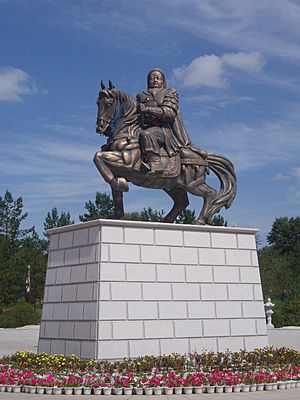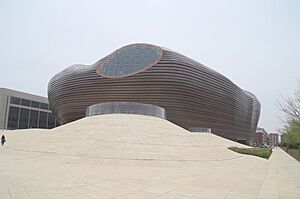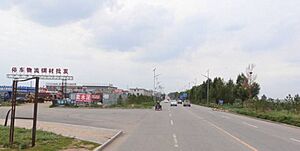Ordos City facts for kids
Quick facts for kids
Ordos
|
|
|---|---|
|
Prefecture-level city
|
|
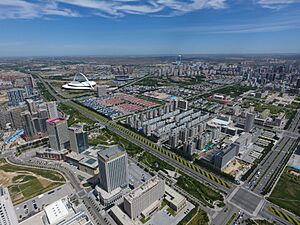
View of Dongsheng District
|
|
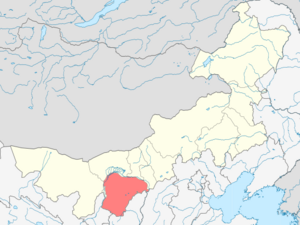
Location of Ordos City jurisdiction in Inner Mongolia (orange)
|
|
| Country | People's Republic of China |
| Region | Inner Mongolia |
| Municipal seat | Kangbashi District |
| Area | |
| • Prefecture-level city | 86,752 km2 (33,495 sq mi) |
| • Urban
(2017)
|
2,526.5 km2 (975.5 sq mi) |
| • Metro | 5,859.8 km2 (2,262.5 sq mi) |
| Elevation | 1,305 m (4,281 ft) |
| Highest elevation | 2,149 m (7,051 ft) |
| Lowest elevation | 850 m (2,790 ft) |
| Population
(2020 census)
|
|
| • Prefecture-level city | 2,153,638 |
| • Density | 24.82523/km2 (64.2970/sq mi) |
| • Urban
|
693,038 |
| • Urban density | 274.308/km2 (710.453/sq mi) |
| • Metro | 366,779 |
| • Metro density | 62.5924/km2 (162.1136/sq mi) |
| GDP | |
| • Prefecture-level city | CN¥ 422.6 billion US$ 67.9 billion |
| • Per capita | CN¥ 207,163 US$ 33,261 |
| Time zone | UTC+8 (China Standard) |
| Postal code |
017000
|
| ISO 3166 code | CN-NM-06 |
| Licence plate prefixes | 蒙K |
| Administrative division code | 150600 |
| Ordos City | |||||||||||||||||
|---|---|---|---|---|---|---|---|---|---|---|---|---|---|---|---|---|---|
| Chinese name | |||||||||||||||||
| Simplified Chinese | 鄂尔多斯市 | ||||||||||||||||
| Traditional Chinese | 鄂爾多斯市 | ||||||||||||||||
|
|||||||||||||||||
| Mongolian name | |||||||||||||||||
| Mongolian Cyrillic | Ордос хот | ||||||||||||||||
| Mongolian script | ᠣᠷᠳᠣᠰ ᠬᠣᠲᠠ | ||||||||||||||||
|
|||||||||||||||||
Ordos, also known as Ih Ju, is a big city in Inner Mongolia, China. It's located on the Ordos Plateau near the Yellow River. Even though much of the area is countryside, Ordos is managed like a city. In 2020, about 2.1 million people lived here. Its main city areas, Ejin Horo Banner and Kangbashi District, have about 366,000 residents.
Ordos is famous for its new Kangbashi District. This area was built with many grand buildings, museums, and public spaces. It even hosted the Miss World 2012 competition! When Kangbashi was first built, some people called it a "ghost city" because it seemed empty. But by 2017, its population grew a lot, from 30,000 to 153,000 people.
Contents
About the Name of Ordos
The area was called the Ih Ju League from 1649 to 2001. It was renamed Ordos on February 26, 2001. The word "Ordos" means "palaces" in the Mongolian language. It first referred to a tribe and then to their land.
The name "Ordos" comes from the Mongolian word ordu, meaning 'court' or 'palace'. The name is sometimes linked to the eight white yurts of Genghis Khan. The Ordos dialect of Mongolian is quite different from other nearby dialects.
History of Ordos
Ancient Times and Early Civilizations
In the southern part of the Ordos grassland, there's a river called the Sarawusu River. Its name means "thick yellow stream" in Mongolian. In 1923, a French Jesuit named Émile Licent found ancient human fossils here. This site is now part of the Shuidonggou complex. Many old items have been found, some possibly 100,000 years old.
The culture from this time is called "Salawusu" or "Shuidonggou" culture. It's known as a late Paleolithic culture. This culture mixed grassland life with the Yellow River civilization. It's a key part of the northern grasslands' history.
Ordos in Imperial China
Before the Zhou dynasty, this area was home to nomadic groups. During the Warring States Period, it was part of the state of Zhao. Later, it belonged to the state of Qin. In the Han dynasty, it was a frontline area in the Han–Xiongnu War. Emperor Wu of Han created Shuofang County here.
Qin Zhidao and Shuofang County
The Qin Zhidao was an important military road built by Qin Shihuang from 212 BC to 210 BC. It passed through Ordos City. This road helped connect different parts of the empire. Shuofang County was a northern border county during the Han dynasty. It was set up after Emperor Wu's forces regained the Hetao area.
Tongwan City
Tongwan City is located where Ordos City meets Jingbian, Shaanxi Province. It was the capital of the Daxia Kingdom about 1500 years ago. In 407 AD, the Xiongnu leader Helian Bobo built this city. It took seven years to build. The city walls were very thick and tall.
The Eight White Palaces
Legend says that Genghis Khan liked the Ordos area when he passed through it. He wished to be buried there. In 1227, Genghis Khan died. His relics were placed in eight white felt tents for worship. These were called the Eight White Palaces.
Later, Kublai Khan set up special ceremonies for these palaces. They became a very important place for the Mongol Empire. The Eight White Palaces were movable and showed the power of Genghis Khan's family.
Qing Dynasty and Migration
Six Banners League
In 1649, the Qing dynasty divided the Mongolian Ordos tribe into six Banners. These Banners later formed the Ikezhao League, which was the old name for Ordos City.
During the Qing dynasty, China's population grew a lot. Many poor people moved to Ordos and other areas. This movement was called "Zou Xi Kou." It changed the way of life and economy in Mongolia. People from Shanxi province brought their culture to Inner Mongolia.
Modern History of Ordos
After the Republic of China was formed, the Ikezhao League was established. In 1937, Japan occupied much of northern China. In 1938, Japanese invaders tried to move the Eight White Palaces of Genghis Khan. But the local leaders refused.
Due to the war, the Eight White Palaces had to be moved west for safety. They traveled a long way, passing through Yan'an and Xi'an. In 1939, they were placed in Xinglong Mountain, Gansu Province. In 1949, they were moved again to Qinghai.
After the People's Republic of China was founded, the Eight White Palaces were returned to Ejin Horo in 1954. In 2001, Ikezhao League officially became the prefecture-level Ordos City. In 2016, Kangbashi District was officially set up within Ordos City.
Geography and Climate
Ordos covers a large area of about 86,752 square kilometers. It includes most of the Ordos Desert. The city borders Hohhot to the east and Baotou to the northeast. Its longest north-south distance is 340 km, and east-west is 400 km.
The most populated area is Dongsheng District, with over 582,000 people in 2010. Another urban area is Kangbashi District and nearby Altan Xire. Kangbashi is north of the Wulan Mulun River, a branch of the Yellow River.
Ordos has hills in the east and high plateaus in the west and center. There are also sandy deserts in the north and south. The highest point is 2,149 meters, and the lowest is 850 meters.
Two large deserts are in Ordos: the Kubuqi Desert in the north (19.2% of Ordos) and the Mu Us (Maowusu) Desert in the south (28.8% of Ordos).
Ordos has a cold semi-arid climate. Winters are long, cold, and very dry. Summers are warm and a bit humid. Strong winds are common, especially in spring. Most rain falls from July to September. The average temperature in the city ranges from -10.5°C in January to 21.0°C in July.
| Climate data for Ordos (Dongsheng District), elevation 1,462 m (4,797 ft), 1991–2020 normals, extremes 1971–2010) | |||||||||||||
|---|---|---|---|---|---|---|---|---|---|---|---|---|---|
| Month | Jan | Feb | Mar | Apr | May | Jun | Jul | Aug | Sep | Oct | Nov | Dec | Year |
| Record high °C (°F) | 11.3 (52.3) |
16.6 (61.9) |
24.9 (76.8) |
32.2 (90.0) |
32.9 (91.2) |
36.7 (98.1) |
36.5 (97.7) |
33.3 (91.9) |
33.3 (91.9) |
24.4 (75.9) |
18.7 (65.7) |
12.2 (54.0) |
36.7 (98.1) |
| Mean daily maximum °C (°F) | −3.9 (25.0) |
0.6 (33.1) |
7.3 (45.1) |
15.3 (59.5) |
21.2 (70.2) |
25.7 (78.3) |
27.4 (81.3) |
25.2 (77.4) |
20.1 (68.2) |
13.2 (55.8) |
4.8 (40.6) |
−2.4 (27.7) |
12.9 (55.2) |
| Daily mean °C (°F) | −9.3 (15.3) |
−5.1 (22.8) |
1.4 (34.5) |
9.2 (48.6) |
15.3 (59.5) |
20.0 (68.0) |
21.9 (71.4) |
20.0 (68.0) |
14.7 (58.5) |
7.7 (45.9) |
−0.5 (31.1) |
−7.4 (18.7) |
7.3 (45.2) |
| Mean daily minimum °C (°F) | −13.1 (8.4) |
−9.3 (15.3) |
−3.3 (26.1) |
3.8 (38.8) |
9.7 (49.5) |
14.6 (58.3) |
17.1 (62.8) |
15.6 (60.1) |
10.3 (50.5) |
3.3 (37.9) |
−4.3 (24.3) |
−11.1 (12.0) |
2.8 (37.0) |
| Record low °C (°F) | −28.4 (−19.1) |
−27.5 (−17.5) |
−22.8 (−9.0) |
−11.6 (11.1) |
−4.8 (23.4) |
1.7 (35.1) |
9.1 (48.4) |
4.3 (39.7) |
−2.1 (28.2) |
−13.6 (7.5) |
−21.8 (−7.2) |
−27.1 (−16.8) |
−28.4 (−19.1) |
| Average precipitation mm (inches) | 2.1 (0.08) |
4.3 (0.17) |
9.3 (0.37) |
16.2 (0.64) |
31.4 (1.24) |
52.1 (2.05) |
94.5 (3.72) |
89.6 (3.53) |
52.0 (2.05) |
20.7 (0.81) |
9.4 (0.37) |
2.3 (0.09) |
383.9 (15.12) |
| Average precipitation days (≥ 0.1 mm) | 2.3 | 2.6 | 3.8 | 3.8 | 6.7 | 9.4 | 11.5 | 11.3 | 8.8 | 4.8 | 3.1 | 2.4 | 70.5 |
| Average snowy days | 3.8 | 4.5 | 4.3 | 1.5 | 0.2 | 0 | 0 | 0 | 0 | 1.2 | 3.2 | 4.3 | 23 |
| Average relative humidity (%) | 51 | 45 | 38 | 33 | 36 | 44 | 56 | 60 | 57 | 50 | 50 | 50 | 48 |
| Mean monthly sunshine hours | 221.7 | 217.0 | 257.7 | 281.8 | 306.8 | 288.3 | 281.7 | 267.8 | 242.0 | 245.7 | 218.1 | 211.7 | 3,040.3 |
| Percent possible sunshine | 73 | 71 | 69 | 70 | 69 | 65 | 63 | 64 | 66 | 72 | 74 | 73 | 69 |
| Source 1: China Meteorological Administration | |||||||||||||
| Source 2: Weather China | |||||||||||||
Economy and Resources
Ordos is one of China's richest regions based on its economy. In 2016, its wealth per person was very high. This makes it one of the top cities in mainland China.
The city has many natural resources. It holds one-sixth of China's total coal reserves. The main parts of its economy are:
- Textiles (especially wool)
- Coal mining
- Petrochemicals (products made from oil and gas)
- Making electricity
- Producing building materials
- Bitcoin mining
An industrial park in Dalad Banner has one of the world's largest Bitcoin "mines." This is actually a huge server farm owned by a company called Bitmain.
Military Presence
In 2021, news reports said that China was building a new missile site near Hanggin Banner in Ordos City. This site is planned to hold over 100 new DF-41 intercontinental ballistic missiles. These are very long-range missiles. This new site will join two others in China.
Administrative Divisions
Ordos City is divided into two districts and seven banners. These are like smaller regions within the city.
| Map | |||||||
|---|---|---|---|---|---|---|---|
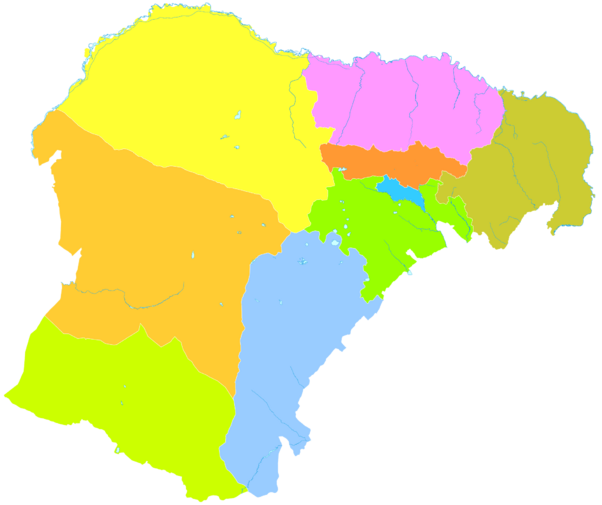
Dongsheng
1
Dalad
Banner Jungar
Banner Otog Front
Banner Otog
Banner Hanggin
Banner Uxin
Banner Ejin'horo
Banner 1.Kangbashi
|
|||||||
| Name | Mongolian | Hanzi | Hanyu Pinyin | Population (2010) | Area (km2) | Density (/km2) | |
| Dongsheng District | ᠳ᠋ᠦᠩᠱᠧᠩ ᠲᠣᠭᠣᠷᠢᠭ (Düŋšėŋ toɣoriɣ) |
东胜区 | Dōngshèng Qū | 582,544 | 2,146 | 271 | |
| Kangbashi District (Hia'bagx District) |
ᠬᠢᠶᠠ ᠪᠠᠭᠰᠢ ᠲᠣᠭᠣᠷᠢᠭ (Kiy-a baγsi toɣoriɣ) |
康巴什区 | Kāngbāshí Qū | 153,000 | 372.55 | 404 | |
| Dalad Banner | ᠳᠠᠯᠠᠳ ᠬᠣᠰᠢᠭᠤ (Dalad qosiɣu) |
达拉特旗 | Dálātè Qí | 322,101 | 8,192 | 40 | |
| Jungar Banner | ᠵᠡᠭᠦᠨᠭᠠᠷ ᠬᠣᠰᠢᠭᠤ (Jegünɣar qosiɣu) |
准格尔旗 | Zhǔngé'ěr Qí | 356,501 | 7,535 | 36 | |
| Otog Front Banner (Otog Omnod Banner) |
ᠣᠲᠣᠭ ᠤᠨ ᠡᠮᠦᠨᠡᠳᠦ ᠬᠣᠰᠢᠭᠤ (Otoɣ-un Emünedü qosiɣu) |
鄂托克前旗 | Ètuōkè Qián Qí | 68,282 | 12,318 | 6 | |
| Otog Banner | ᠣᠲᠣᠭ ᠬᠣᠰᠢᠭᠤ (Otoɣ qosiɣu) |
鄂托克旗 | Ètuōkè Qí | 148,844 | 20,064 | 4 | |
| Hanggin Banner | ᠬᠠᠩᠭᠢᠨ ᠬᠣᠰᠢᠭᠤ (Qaŋɣin qosiɣu) |
杭锦旗 | Hángjǐn Qí | 111,102 | 18,903 | 7 | |
| Uxin Banner | ᠦᠦᠰᠢᠨ ᠬᠣᠰᠢᠭᠤ (Üüsin qosiɣu) |
乌审旗 | Wūshěn Qí | 124,527 | 11,645 | 9 | |
| Ejin Horo Banner | ᠡᠵᠢᠨ ᠬᠣᠷᠣᠭᠠ ᠬᠣᠰᠢᠭᠤ (Ejin Qoroɣ-a qosiɣu) |
伊金霍洛旗 | Yījīnhuòluò Qí | 226,752 | 5,958 | 23 | |
Kangbashi New Area
A large new city area called Kangbashi was built about 25 km from Dongsheng District. It was planned to house a million people. At first, it was mostly empty. In 2010, government numbers showed only 28,000 residents. Some news reports even called it a "ghost city."
However, by 2017, the population had grown to 153,000. Housing prices also went up by 50% since 2015. Out of 40,000 apartments built since 2004, only 500 were still for sale. This shows that the city is now much more active.
Ordos Museum
In 2011, the Ordos Museum opened in Kangbashi. This large museum covers 49,400 square meters. It was designed by MAD Studio, an architectural firm from China. The museum teaches visitors about the history of the Ordos area. It also shares information about the culture and traditions of Inner Mongolia.
Transportation in Ordos
Most travel within Ordos City is by car or bus. The city has a good network of roads. Two main expressways, the G18 Rongcheng–Wuhai Expressway and the G65 Baotou–Maoming Expressway, connect Ordos to other cities.
In 2016, the Ordos railway station opened. This station is part of several railway lines. High-speed trains run daily to Hohhot, the provincial capital. Slower trains also connect directly to and from Beijing West railway station.
Ordos Ejin Horo International Airport is located in Ejin Horo Banner. This airport helps people travel to and from Ordos by air.
Population and People
In the 2000 census, Ordos had 1,369,766 people. Most of the people living in Ordos are Han Chinese.
| ethnic group | population | share |
|---|---|---|
| Han | 1,207,971 | 88.19% |
| Mongols | 155,845 | 11.38% |
| Manchu | 2,905 | 0.21% |
| Hui | 1,861 | 0.14% |
| Tibetans | 1,023 | 0.07% |
Many people living in Ordos came from the Shanxi province, which is about 30 km south of the city.
Images for kids
See also
 In Spanish: Ciudad de Ordos para niños
In Spanish: Ciudad de Ordos para niños


